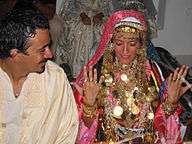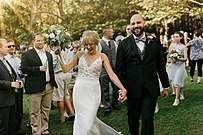Wedding
A wedding is a ceremony where two or more people are united in marriage. Wedding traditions and customs vary greatly between cultures, ethnic groups, religions, countries, and social classes. Most wedding ceremonies involve an exchange of marriage vows by a couple, presentation of a gift (offering, rings, symbolic item, flowers, money, dress), and a public proclamation of marriage by an authority figure or celebrant. Special wedding garments are often worn, and the ceremony is sometimes followed by a wedding reception. Music, poetry, prayers, or readings from religious texts or literature are also commonly incorporated into the ceremony, as well as superstitious customs originating in Ancient Rome.
Relationships (Outline) | |||||||||
|---|---|---|---|---|---|---|---|---|---|
|
Types
|
|||||||||
|
Endings
|
|||||||||
|
|||||||||
|
Practices
|
|||||||||
Common elements across cultures
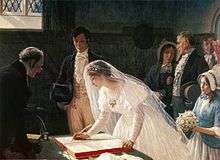
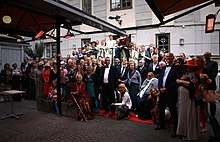
Some cultures have adopted the traditional Western custom of the white wedding, in which a bride wears a white wedding dress and veil. This tradition was popularized through the marriage of Queen Victoria. Some say Victoria's choice of a white gown may have simply been a sign of extravagance, but may have also been influenced by the values she held which emphasized sexual purity.[1] Within the modern 'white wedding' tradition, a white dress and veil are unusual choices for a woman's second or subsequent wedding.
The use of a wedding ring has long been part of religious weddings in Europe and America, but the origin of the tradition is unclear. One possibility is the Roman belief in the Vena amoris, which was believed to be a blood vessel that ran from the fourth finger (ring finger) directly to the heart. Thus, when a couple wore rings on this finger, their hearts were connected. Historian Vicki Howard points out that the belief in the "ancient" quality of the practice is most likely a modern invention.[2] "Double ring" ceremonies are also a modern practice, a groom's wedding band not appearing in the United States until the early 20th century.[3]
The exit from the wedding ceremony is also called the "send off", and often includes traditional practices, such as the newlyweds and the wedding party bowing and kissing the knees of the elders in Ethiopian weddings. The send off often includes throwing rice (a symbol of prosperity and fertility)[4] or other seeds at the newlyweds in most of the Western world,[5] as well as for example India[4] and Malaysia.[6] Despite fears of the opposite, the use of uncooked rice for this purpose is not harmful to birds.[7]
The wedding ceremony is often followed by wedding reception or a wedding breakfast, in which the rituals may include speeches from the groom, best man, father of the bride and possibly the bride,[8] the newlyweds' first dance as a couple, and the cutting of an elegant wedding cake. In recent years traditions has changed to include a father-daughter dance for the bride and her father, and sometimes also a mother-son dance for the groom and his mother.
Traditional wedding attire
- Ao dai, traditional garments of Vietnam
- Barong Tagalog, an embroidered, formal men's garment of the Philippines
- Batik and Kebaya, a garment worn by the Javanese people of Indonesia and also by the Malay people of Malaysia
- Dashiki, the traditional West African wedding attire
- Dhoti, male garment in South India
- Hanbok, the traditional garment of Korea
- Kilt, male garment particular to Scottish culture[9][10][11]
- Kittel, a white robe worn by the groom at an Orthodox Jewish wedding. The kittel is worn only under the chuppah, and is removed before the reception.
- Kua (or 裙褂 [kwàhn kwáa]), Chinese traditional formal wear
- Ribbon shirt, often worn by American Indian men on auspicious occasions, such as weddings, another common custom is to wrap bride and groom in a blanket
- Sari/Lehenga, Indian popular and traditional dress in India
- Seshweshe, female dress worn by the Basotho women during special ceremonies. Although it has recently been adopted to men attire as well.
- Sherwani, a long coat-like garment worn in South Asia
- Shiromuku Kimono, a traditional wedding garment in Japan
- Tiara, or wedding crown, worn by Syrian and Greek couples (which are called "τα στέφανα," which literally means "wreaths") and Scandinavian brides
- Topor, a type of conical headgear traditionally worn by grooms as part of the Bengali Hindu wedding ceremony
- Western dress code
- Morning dress, western daytime formal dress
- Stroller
- White tie ("evening dress" in the U.K; very formal evening attire)
- Black tie or Evening Suit ("dinner jacket" in the U.K; often referred to as a "tuxedo" in the U.S; traditionally appropriate only for use after 6:00 p.m. (not for weddings), but also seen in daytime, especially in the United States. It is considered inappropriate in Britain)
- Non-traditional "tuxedo" variants (colored jackets/ties, "wedding suits")
- Lounge suit
- Wedding veil, popularized by Queen Victoria, was a long held custom in which the 'purity' and 'innocence' of the bride could thwart away evil spirits.
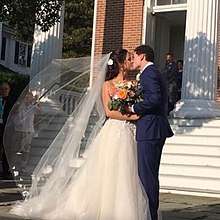 Traditional western wedding veil
Traditional western wedding veil - Wedding dress (or bridal gown), a special dress worn by the bride.
- Different wedding clothing around the world
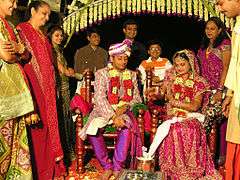 Hindu wedding in India
Hindu wedding in India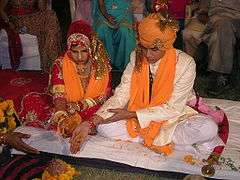 A bride and a bridegroom in Rajasthan
A bride and a bridegroom in Rajasthan- A bride and a bridegroom in Nepal
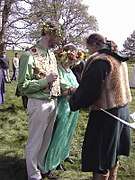 Neopagan handfasting ceremony
Neopagan handfasting ceremony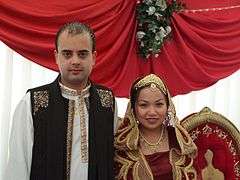 A muslim couple in India
A muslim couple in India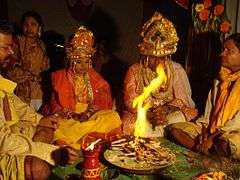 Fire rituals at a Hindu wedding, India
Fire rituals at a Hindu wedding, India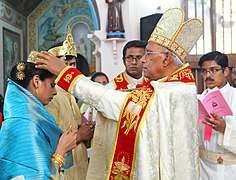 Crowning during a Nasrani wedding in the Syro-Malabar Catholic Church
Crowning during a Nasrani wedding in the Syro-Malabar Catholic Church Japanese bride and bridegroom
Japanese bride and bridegroom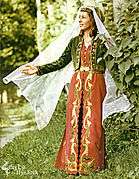 Traditional Armenian wedding dress
Traditional Armenian wedding dress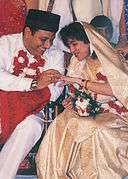 A Parsi wedding
A Parsi wedding Assyrian bride and groom
Assyrian bride and groom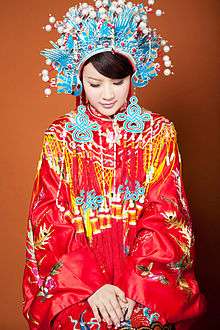 Chinese traditional wedding dress, Qing Dynasty style
Chinese traditional wedding dress, Qing Dynasty style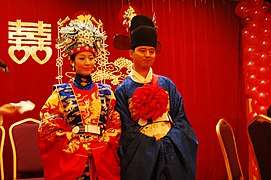 Chinese traditional wedding clothing, Ming Dynasty style
Chinese traditional wedding clothing, Ming Dynasty style Chinese traditional wedding attire, Zhou Dynasty style
Chinese traditional wedding attire, Zhou Dynasty style.jpg) Wedding at Burning Man
Wedding at Burning Man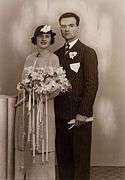 Wedding 1935 in Barcelona, Spain
Wedding 1935 in Barcelona, Spain Minangkabau marriage in Indonesia
Minangkabau marriage in Indonesia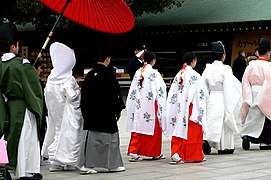 Japanese wedding at the Meiji Shrine
Japanese wedding at the Meiji Shrine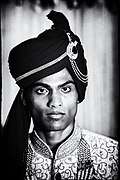 Groom in traditional dress of Bangladesh in wedding ceremony.
Groom in traditional dress of Bangladesh in wedding ceremony.
Wedding music
Western weddings
Music played at Western weddings includes a processional song for walking down the aisle (ex: wedding march) either before or after the marriage service. An example of such use is reported in the wedding of Nora Robinson and Alexander Kirkman Finlay in 1878.[12]
The "Bridal Chorus" from Lohengrin by Richard Wagner, commonly known as "Here Comes the Bride", is often used as the processional. Wagner is said to have been anti-Semitic,[13] and as a result, the Bridal Chorus is normally not used at Jewish weddings.[14] UK law forbids music with any religious connotations to be used in a civil ceremony.[15]
Johann Pachelbel's Canon in D is an alternative processional.[16] Other alternatives include various contemporary melodies, such as Bob Marley's One Love, which is sometimes performed by a steel drum band.[3]
In the United States, approximately 2 million people get married each year and close to 70 million people attend a wedding and spend more than $100 on a gift.[17]
Religious aspects of weddings
Most religions recognize a lifelong union with established ceremonies and rituals. Some religions permit polygamous marriages or same-sex marriages.
Many Christian faiths emphasize the raising of children as a priority in a marriage. In Judaism, marriage is so important that remaining unmarried is deemed unnatural. Islam also recommends marriage highly; among other things, it helps in the pursuit of spiritual perfection. The Bahá'í Faith sees marriage as a foundation of the structure of society, and considers it both a physical and spiritual bond that endures into the afterlife.[18] Hinduism sees marriage as a sacred duty that entails both religious and social obligations. By contrast, Buddhism does not encourage or discourage marriage, although it does teach how one might live a happily married life and emphasizes that marital vows are not to be taken lightly.
Different religions have different beliefs as regards the breakup of marriage. For example, the Roman Catholic Church believes that marriage is a sacrament and a valid marriage between two baptized persons cannot be broken by any other means than death. This means that civil divorcés cannot remarry in a Catholic marriage while their spouse is alive. In the area of nullity, religions and the state often apply different rules. A couple, for example, may begin the process to have their marriage annulled by the Catholic Church only after they are no longer married in the eyes of the civil authority.
Customs associated with various religions and cultures
Christian customs
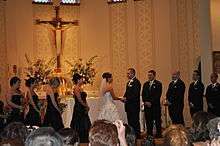
Most Christian churches give some form of blessing to a marriage, which is seen as a sacred institution in some sense, although terminology and associated theological meanings vary widely from one denomination to another: e.g., "holy matrimony," "sacrament of marriage," "holy ordinance of marriage," "holy union," and so forth.
In some Western countries, a separate and secular civil wedding ceremony is required for recognition by the state, while in other Western countries, couples must merely obtain a marriage license from a local government authority and can be married by Christian or other clergy authorized by law to do so.
Since the beginning of the 21st century, same-sex couples have been allowed to marry civilly in many countries, and some Christian churches in those countries allow religious marriages of same-sex couples, though some forbid it. See the article Same-sex marriage.
A Christian wedding ceremony typically includes mutual vows or solemn promises of lifelong love and fidelity by the couple, and may include some sort of pledge by the community to support the couple's relationship. A church wedding is a ceremony held in a church building and presided over by a Christian priest, minister, or pastor; weddings may also take place outdoors or in secular buildings if permitted by the rules of a particular denomination.
Wedding ceremonies typically contain prayers and readings from the Holy Bible and reflect the church's teachings about the spiritual significance of marriage, as well as its purpose and obligations. The wedding service is sometimes combined with a Mass or Holy Communion.[19]
Customs may vary widely among denominations. Pre-marital counseling may be urged or required for the engaged couple.[20] In some countries or denominations, the reading of banns of marriage may also be required before the wedding date.[21]
In the Roman Catholic Church, Holy Matrimony is considered to be one of the seven sacraments, in this case one that the spouses bestow upon each other in front of a priest and members of the community as witnesses. As with all sacraments, it is seen as having been instituted by Jesus himself (see Gospel of Matthew 19:1–2, Catechism of the Catholic Church §1614–1615). In the Eastern Orthodox Church, it is one of the Mysteries, and is seen as an ordination and a martyrdom. The wedding ceremony of Saint Thomas Christians, an ethnoreligious group of Christians in India, incorporates elements from Hindu, Jewish and Christian weddings.
Protestant weddings may be elaborate or simple. For example, in the United Methodist Church, the Service of Christian Marriage (Rite I) includes the elements found in a typical Sunday service, such as hymns, prayers, and readings from the Bible, as well as other elements unique to a wedding, including the exchange of marriage vows and wedding rings, and a special benediction for the couple.[22] Holy Communion may be part of the wedding service in litturgical Protestant churches (e.g., Anglican, Lutheran, or high-church Methodist), but is rarely, if ever, found in weddings of other low-church Protestant denominations.
A Quaker wedding ceremony in a Friends meeting is similar to any other meeting for worship, and therefore often very different from the experience expected by non-Friends.
Hindu customs

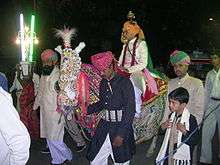
Hindu ceremonies are usually conducted totally or at least partially in Sanskrit, the language of the Hindu scriptures. The wedding celebrations may last for several days and they can be extremely diverse, depending upon the region, denomination and caste. Mehendi ceremony is a traditional ritual in Hindu weddings, where Henna application takes place on bride's hands and legs, before the wedding. On the wedding day, the bride and the bridegroom garland each other in front of the guests. Most guests witness only this short ceremony and then socialize, have food and leave. The religious part (if applicable) comes hours later, witnessed by close friends and relatives. In cases where a religious ceremony is present, a Brahmin (Hindu priest) arranges a sacred yajna (fire-sacrifice), and the sacred fire (Agni) is considered the prime witness (sākshī) of the marriage. He chants mantras from the Vedas and subsidiary texts while the couple are seated before the fire. The most important step is saptapadi or saat phere, wherein the bride and the groom, hand-in-hand, encircle the sacred fire seven times, each circle representing a matrimonial vow. Then the groom marks the bride's hair parting with vermilion (sindoor) and puts a gold necklace (mangalsutra) around her neck. Several other rituals may precede or follow these afore-mentioned rites. Then the bride formally departs from her blood-relatives to join the groom's family.
Jewish customs
A traditional Jewish wedding usually follows this format:[23][24][25][26][27]
- Before the ceremony, the couple formalize a written ketubah (marriage contract), specifying the obligations of husband to the wife and contingencies in case of divorce. The ketubah is signed by two witnesses and later read under the chuppah (wedding canopy).
- The couple is married under the chuppah signifying their new home together. The chuppah can be made from a piece of cloth or other material attached to four poles, or a giant tallit (prayer shawl) held over the couple by four family members or friends.
- The wedding couple is accompanied by both sets of parents and they join the wedding couple under the chuppah.
- In Orthodox Jewish weddings, the bride is accompanied to the chuppah by both mothers and the groom is accompanied to the chuppah by both fathers.
- Seven blessings are recited, blessing the bride and groom and their new home.
- The couple sip a glass of wine from a Kiddush cup .
- The groom will smash a wine glass with his right foot, ostensibly in remembrance of the destruction of the Second Temple.
- In Reform Jewish weddings, the bride and groom can smash the wine glass together.
- At some weddings, the couple may declare that each is sanctified to the other, repeat other vows and exchange rings.
- In Orthodox Jewish weddings, the bride does not speak under the chuppah and only she receives a ring. The groom recites "Harei at mekudeshet li k'dat Moshe V'Yisrael"- "behold you are [thus] sanctified to me by the law of Moses and Israel" as he places the ring on the bride's right index finger. The bride's silence and acceptance of the ring signify her agreement to the marriage. This part of the ceremony is called kiddushin. The groom's giving an object of value to the bride is necessary for the wedding to be valid.
- In more egalitarian weddings, the bride responds verbally, often giving the groom a ring in return. A common response is "ani l'dodi, v'dodi li" (I am my beloved's, my beloved is mine)
- In some Orthodox weddings, the groom then says:
- "If I forget you, O Jerusalem, may my right hand forget its skill.
- May my tongue cling to the roof of my mouth.
- If I do not remember you,
- if I do not consider Jerusalem in my highest joy."
- The ceremony ends with the groom breaking a glass underfoot.
- The couple spend their first moments as man and wife in seclusion (apart from the wedding guests, and with no other person present). This cheder yichud – "the room of seclusion (or 'oneness')" halachically strengthens the marriage bond, since Orthodox Jews are forbidden to be secluded with an unrelated person of the opposite sex.
- The ceremony is followed by a seudat mitzvah, the wedding meal, as well as music and dancing.
- At the conclusion of the wedding meal, Birkat Hamazon (Grace After Meals) is recited, as well as the seven wedding blessings.
In more observant communities, the couple will celebrate for seven more days, called the Sheva Brachot (seven blessings) during which the seven wedding blessings are recited at every large gathering during this time.
Islamic customs
.jpg)
A wedding is typically a happy time for families to celebrate. In the Muslim world, there are colorful, cultural variations from place to place.[28]
Two male witnesses who are the members of family in most cases, are required for Nikah. According to the Quran, a married Muslim couple, both husband and wife act as each other's protector and comforter and therefore only meant "for each other".
All Muslim marriages have to be declared publicly and are never to be undertaken in secret. For many Muslims, it is the ceremony that counts as the actual wedding alongside a confirmation of that wedding in a registry office according to fiqh, in Islam a wedding is also viewed as a legal contract particularly in Islamic jurisprudences. However, most Muslim cultures separate both the institutions of the mosque and marriage, no religious official is necessary, but very often an Imam presides and performs the ceremony, he may deliver a short sermon.[29] Celebrations may differ from country to country depending on their culture but the main ceremony is followed by a Walima (the marriage banquet).
In Islam, polygyny is allowed with certain religious restrictions, despite that an overwhelming majority of Muslims traditionally practice monogamy.
It is forbidden in Islam for parents or anyone else: to force, coerce, or trick either man or woman into a marriage that is contrary to the individual will of any one of the couple. It is also necessary for all marriages commence with the best of intentions.
Chinese customs
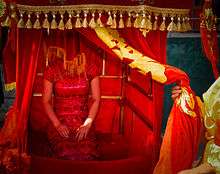
At traditional Chinese weddings, the tea ceremony is the equivalent of an exchange of vows at a Western wedding ceremony. This ritual is still practiced widely among rural Chinese; however, young people in larger cities, as well as in Taiwan, Hong Kong, Malaysia and Singapore, tend to practice a combination of Western style of marriage together with the tea ceremony.
When the bride leaves her home with the groom to his house, a "Good Luck Woman" will hold a red umbrella over her head, meaning, "Raise the bark, spread the leaves." This "Good Luck Woman" should be someone who is blessed with a good marriage, healthy children and husband and living parents. Other relatives will scatter rice, red beans and green beans in front of her. The red umbrella protects the bride from evil spirits, and the rice and beans are to attract the attention of the gold chicken.[30]
The newlyweds kneel in front of parents presenting tea. A Good Luck Woman making the tea says auspicious phrases to bless the newlyweds and their families. The newlyweds also present tea to each other, raising the tea cups high to show respect before presenting the tea to each other.
The attendants receiving the tea usually give the bride gifts such as jewelry or a red envelope.
The tea ceremony is an official ritual to introduce the newlyweds to each other's family, and a way for newlyweds to show respect and appreciation to their parents. The newlyweds kneel in front of their parents, serving tea to both sides of parents, as well as elder close relatives. Parents give their words of blessing and gifts to the newlyweds.
Humanist weddings
While many wedding traditions and rituals have origins in religions and are still performed by religious leaders, some marriage traditions are cultural and predate the prevalent religions in those regions. Non-religious people will often want to have a wedding that is secular (not religious) in content. In order to meet this demand, secular ceremonies by carried out by humanist celebrants first developed in the 19th century. Humanists UK members pioneered humanist weddings in the 1890s, and its weddings continue to be popular with couples across England, Wales, and Northern Ireland. In Scotland, Humanist Society Scotland (HSS) has carried out secular ceremonies in the country since the 1980s. These have been legally recognised since 2005,[31] and became more numerous than church weddings in 2018.[32][33]
Humanist wedding ceremonies are carried out in a variety of countries like the U.S., Canada and recently Brazil, having legal status in only a few of these countries. Humanist celebrants are able to perform valid civil marriages and civil partnerships in the Republic of Ireland. Secular weddings are becoming more popular in Ireland due to a declining influence of the Catholic Church.[34] Since 2015, Irish humanists have conducted more weddings than the Church of Ireland.[35]
Wedding types
Civil wedding
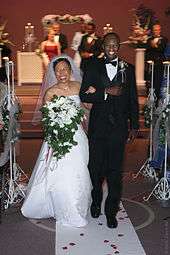
A civil wedding is a ceremony presided over by a local civil authority, such as an elected or appointed judge, Justice of the peace or the mayor of a locality. Civil wedding ceremonies may use references to God or a deity (except in U.K law where readings and music are also restricted), but generally no references to a particular religion or denomination. They can be either elaborate or simple. Many civil wedding ceremonies take place in local town or city halls or courthouses in judges' chambers.[36]
Destination wedding
Not to be confused with an elopement, a destination wedding is one in which a wedding is hosted, often in a vacation-like setting, at a location to which most of the invited guests must travel and often stay for several days. This could be a beach ceremony in the tropics, a lavish event in a metropolitan resort, or a simple ceremony at the home of a geographically distant friend or relative. During the recession of 2009, destination weddings continued to see growth compared to traditional weddings, as the typically smaller size results in lower costs.[37]
Weddings held at prestigious venues such as castles or stately homes have become increasingly popular in the 21st century particularly in European countries such as the UK, France and Germany. From 2010 onwards, there has been an increase in destination weddings that are hosted in exotic places like Indonesia, Maldives, India, and Pakistan.
Double wedding
A double wedding is a double ceremony where two affianced couples rendezvous for two simultaneous or consecutive weddings. Typically, a fiancé with a sibling who is also engaged, or four close friends in which both couples within the friendship are engaged might plan a double wedding where both couples legally marry.
Elopement
Elopement is the act of getting married, often unexpectedly, without inviting guests to the wedding. In some cases, a small group of family or friends may be present, while in others, the engaged couple may marry without the consent or knowledge of parents or others. While the couple may or may not be widely known to be engaged prior to the elopement, the wedding itself is generally a surprise to those who are later informed of its occurrence.
Handfasting
A handfasting is an old pagan custom, dating back to the time of the ancient Celts. A handfasting was originally more like an engagement period, where two people would declare a binding union between themselves for a year and a day. The original handfasting was a trial marriage.[38]
Highland or Scottish wedding

A Highland or Scottish wedding has the groom, with some or all of the groom's men wear a kilt. The bride may wear a sash or other tartan clothing. The Scottish basket sword is used for any Saber Arch.
Mass wedding
A collective or mass wedding is a single ceremony where numerous couples are married simultaneously.
Military wedding
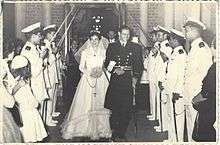
A military wedding is a ceremony conducted in a military chapel and may involve a Saber Arch. In most military weddings the bride, groom or both will wear a military dress uniform in lieu of civilian formal wear. Some retired military personnel who marry after their service has ended may opt for a military wedding.
Peasant wedding
A peasant wedding is a Dutch carnival custom. Not everywhere in Limburg and Brabant is a boerenbruiloft (peasant's wedding) part of the carnival. Especially in the northern and central part of Limburg and eastern part of North Brabant is the boerenbruiloft very often held during the carnival and is an important part of the carnival culture. Each carnival association has its own tradition concerning choosing the spouse for a wedding. Often the bride and groom are chosen by the council of eleven or by the couple that was married the year before. It is not necessary that the newlyweds are a couple in real life. It is also not necessary that the bride and groom are single. Both the bride and groom, however, should be in love during the carnival and they need to transfer their love to all the people who celebrate their wedding along with them. The highlight of the festival of the peasant wedding is the wedding and feast of the onecht (not-marriage) of the bride and groom. There are many aspects that can be found in a real-life marriage. First the engagement will be announced just as if it would be an official marriage. And both the families should learn to know each other very well in organizing the party and the ceremony, like a normal wedding. The two families prepare a piece of entertainment for the wedding.[39] And just like a real wedding, a reception and a feast is organized where guests are asked to wear appropriate clothing. The bride and groom will often dress in wedding clothing from before 1940. The bride for example will often wear a poffer, which is a traditional Brabantian headdress.[40]
Same-sex wedding
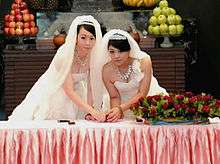
A marriage between two people of the same sex.
Shotgun wedding
A shotgun wedding is a wedding in which the groom is reluctant to marry the bride, however, is strongly encouraged to do so to avoid family, social or legal repercussions. In many cases, the bride is pregnant before the wedding and the family of the bride, most commonly the bride's father, insists that the groom marry the bride before the pregnancy becomes obvious.
Vow renewal wedding
A wedding vow renewal is a ceremony in which a married couple renews or reaffirms their wedding vows. Typically, this ceremony is held to commemorate a milestone wedding anniversary. It may also be held to recreate the marriage ceremony in the presence of family and friends, especially in the case of an earlier elopement.
Weekend wedding
A weekend wedding is a wedding in which couples and their guests celebrate over the course of an entire weekend. Special activities, such as spa treatments and golf tournaments may be scheduled into the wedding itinerary. Lodging usually is at the same facility as the wedding and couples often host a Sunday brunch for the weekend's finale.
White wedding
_(3527495977).jpg)
A white wedding is a term for a traditional formal or semi-formal Western wedding. This term refers to the color of the wedding dress, which became popular after Queen Victoria wore a pure white gown when she married Prince Albert and many were quick to copy her choice. At the time, the color white symbolized both extravagance and virginal purity to many and had become the color for use by young women being formally presented to the royal court.[1]
Wedding ceremony participants

.jpg)
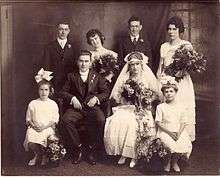
Wedding ceremony participants, also referred to as the wedding party, are the people that participate directly in the wedding ceremony itself.
Depending on the location, religion, and style of the wedding, this group may include only the individual people that are marrying, or it may include one or more brides, grooms (or bridegrooms), persons of honor, bridespersons, best persons, groomsmen, flower girls, pages, and ring bearers.
A "bride's party" consists of those on her side, while a "groom's party" consists of those on his side.
- Bride: The woman about to be married.
- Bridegroom or Groom: The man about to be married.
- Marriage officiant: The person who officiates at the wedding, validating the wedding from a legal and/or religious standpoint. This person may be a judge, justice of the peace, or a member of the clergy. In Hindu marriages, the marriage officiant is called a pandit or Brahmin.
- Best Man, Woman, or Person: The chief assistant to a bridegroom at a wedding, typically a sibling or friend of special significance in his life. Often holds the wedding rings until their exchange.
- Mothers of the Bride and Groom
- Fathers of the Bride and Groom
- Maid, Matron or Man of Honor: the title and position held by a bride's chief attendant, typically her closest friend or sibling.
- Bridesmaids: the female attendants to a bride. Males in this role may be called honor attendants or sometimes bridesmen, but that term has a different traditional meaning.
- Groomsmen or Ushers: the attendants, usually male, to a bridegroom in a wedding ceremony. Female attendants, such as a sister of the groom, are typically called honor attendants.
- Pages: Young attendants may carry the bride's train. In a formal wedding, the ring bearer is a special page who carries the rings down the aisle. The coin bearer is similar page who marches on the wedding aisle to bring the wedding coins.
- Flower girls: In some traditions, one or more children carry bouquets or drop flower petals in front of the bride in the wedding procession.
Wedding industry
The global wedding industry was worth $300 billion as of 2016. The United States wedding industry alone was estimated to be worth $60 billion as of the same year. In the United States, the wedding industry employs over one million people throughout 600,000 businesses, and grows 2% each year. The industry has undergone a transition due to the increased use of technology. Bridal websites, blogs, and social media accounts have driven spending up and created new trends and traditions.[41]
In 2016 alone the average cost of a wedding in the U.S. was estimated to be at $35,329,[42] though the average American spent around $14,399[43] that year. According to one scholarly study of American couples, extravagant spending on weddings is associated with debt stress and short-lived marriages that end in divorce.[44] Couples who spent less than US $10,000 on all wedding-related expenses, and who had a relatively large number of guests in attendance, were the least likely to divorce.[44]
See also
- Elopement
- Wedding cake
- Wedding reception
- White wedding
- Wedding customs by country
References
- Otnes, Cele & Pleck, Elizabeth (2003). Cinderella Dreams: the Allure of the Lavish Wedding, p. 31. University of California Press, Berkeley.
- Howard, Vicky (2006). Brides Inc.: American Weddings and the Business of Tradition, p. 34. University of Pennsylvania Press, Philadelphia.
- Howard, Vicky (2006). Brides Inc.: American Weddings and the Business of Tradition, p. 61. University of Pennsylvania Press, Philadelphia.
- B Singh (2013). "Marketing strategies of rice exporters" (PDF).
- Xu, Guobin; Chen, Yanhui; Xu, Lianhua (2018). "Western Folklore". Introduction to Western Culture. pp. 163–187. doi:10.1007/978-981-10-8153-8_6. ISBN 978-981-10-8152-1.
- Abd. Razak Aziz, Awang Azaman Awang Pawi (December 1, 2016). "Redefining Malay Food in the Post Malaysia's New Economic Policy (NEP)" (PDF). Journal of Tourism, Hospitality & Culinary Arts (JTHCA). 8 (2).
- "Fact or Fiction: Uncooked Rice is Bad for Birds". American Chemical Society. November 5, 2018.
- Archived August 14, 2012, at the Wayback Machine
- "Kilts: tightly woven into Scots culture". Scotsman. February 10, 2005. Archived from the original on February 2, 2007. Retrieved April 16, 2007.
- "The Scottish Kilt". Visit Scotland. Retrieved April 16, 2007.
- Jim Murdoch. "Scottish Culture and Heritage: The Kilt". Scotsmart. Retrieved April 16, 2007.
- "Marriage of Mr A.K. Finlay and Miss Robinson". The Queanbeyan Age. NSW. August 14, 1878. p. 1. Retrieved September 4, 2013.
- Cooke, Deryck V. "Richard Wagner | German composer". Britannica.com. Retrieved November 10, 2015.
- Pollack, Suzanne (September 25, 2015) "No Wagner for You", Washington Jewish Week. Retrieved December 26, 2019.
- "England and Wales", Music Not Allowed at Civil Ceremonies (article), Wedding Music Designer (Simon Jordan)
- Hassall, Jill (2012). "Canon+in+D+by+Pachelbel" The Greatest Guide to Your Dream Wedding. Greatest Guides. p. 53. ISBN 9781907906060. Retrieved November 20, 2017.
- Tiffany, Kaitlyn (March 1, 2019). "Why is the wedding industry so hard to disrupt?". Vox (website). Retrieved March 4, 2019.
- Smith, Peter (2000). "Marriage". A concise encyclopedia of the Bahá'í Faith. Oxford: Oneworld Publications. pp. 232–233. ISBN 1-85168-184-1.
- "Wedding arrangements". June 23, 2008. Archived from the original on December 16, 2008. Retrieved November 10, 2015.
- The Book of Worship for Church and Home: With Orders of Worship, Services for the Administration of the Sacraments and Other Aids to Worship According to the Usages of the Methodist Church. Methodist Publishing House. 1964. p. 32. Retrieved March 25, 2017.
- Tucker, Karen B. Westerfield (April 27, 2011). American Methodist Worship. Oxford University Press. p. 188. ISBN 9780190454203.
- "A Service of Christian Marriage". Discipleship Ministries. 1992. Retrieved March 28, 2017.
- "Guide to the Jewish Wedding". Retrieved July 3, 2008.
- "Nissuin: The Second of the Two Ceremonies". Retrieved July 3, 2008.
- "Understanding the Jewish Wedding". Archived from the original on September 21, 2007. Retrieved July 3, 2008.
- "Ceremony: Jewish Wedding Rituals". Retrieved July 3, 2008.
- "Marriage in Jewish Art". Retrieved July 3, 2008.
- Dodge, Christine Huda. "Islamic Wedding Party Customs". About.com. Retrieved June 8, 2013.
- "Religions – Islam: Weddings". BBC. Retrieved November 10, 2015.
- Siu, Tyrone. "Chicken ceremony rooted in ancient rites". Retrieved July 8, 2018.
- "Humanist Society Scotland | Celebrate the one life we have". Humanism-scotland.org.uk. August 28, 2015. Retrieved November 10, 2015.
- "Scottish humanists to overtake Kirk weddings". BBC Scotland. June 18, 2015. Retrieved May 31, 2017.
- Brocklehurst, Steven (August 2016). "More than 4200 Humanist weddings took place in Scotland last year". Humanist Society Scotland. Retrieved May 31, 2017.
- Walsh, Fionnuala (April 11, 2019). "Less than half of Irish weddings are Catholic". The Times. Archived from the original on April 18, 2019. Retrieved May 22, 2019.
- "Success! Couple win challenge to lack of legal recognition of humanist marriages in Northern Ireland". Humanists UK. June 9, 2017. Retrieved June 9, 2017.
- Gavira, Juan. "Characteristics of a spanish wedding" Archived March 3, 2016, at the Wayback Machine. Juangavira.com
- Parsons, Claudia (May 12, 2009). "Destination weddings see growth despite recession". Reuters. Retrieved November 10, 2015.
- "About Handfastings". Handfastings.org. Retrieved November 10, 2015.
- "Wedding Day Invitation Styles and Designs – A Vintage Approach". Houseplantation. Retrieved August 26, 2016.
- "Boerenbruiloft: hoezo in het 'onecht' verbonden? | Vastelaovend en Carnaval in Limburg". Vastelaovendinlimburg.nl. April 8, 2013. Retrieved October 29, 2013.
- http://www.huffingtonpost.com/matt-douglas/part-1-the-past-present-f_b_9294420.html
- Lui, Kevin. "This Is How Much It Now Costs to Get Married in the U.S. on Average". Fortune. Retrieved June 30, 2017.
- 2016 U.S. Median Cost of a Wedding was $14,399, The Wedding Institute, retrieved September 1, 2017
- Francis-Tan, Andrew; Mialon, Hugo M. (September 15, 2014). "'A Diamond is Forever' and Other Fairy Tales: The Relationship between Wedding Expenses and Marriage Duration". Rochester, NY. doi:10.2139/ssrn.2501480. SSRN 2501480. Cite journal requires
|journal=(help)
External links
| Wikimedia Commons has media related to Wedding ceremonies. |
| Wikivoyage has a travel guide for Wedding travel. |

.jpg)
